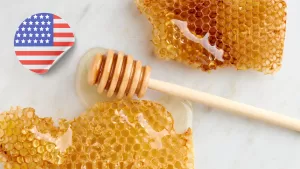The Eastern honey bee, scientifically known as Apis cerana, is a remarkable species of honey bee native to Asia. This bee plays an essential role in pollination and honey production, making it a vital contributor to both ecosystems and agriculture. In this blog post, we will explore the unique characteristics, behavior, importance, and challenges facing the Eastern honey bee, as well as how we can help protect this valuable species.
Table of Contents
ToggleUnderstanding the Eastern Honey Bee
What is the Eastern Honey Bee?
The Eastern honey bee, or Apis cerana, is a social insect that has adapted to various environments across Asia, from tropical to temperate regions. Known for its smaller size compared to its Western counterpart (Apis mellifera), the Eastern honey bee has developed specific traits that enable it to thrive in diverse climates and conditions.
Physical Characteristics
- Size: Apis cerana is generally smaller than the Western honey bee, measuring about 1.2 to 1.5 cm in length.
- Color: It typically exhibits a darker coloration, with a combination of black and yellow or orange bands on its abdomen.
- Body Structure: Eastern honey bees have hairy bodies, which aid in pollen collection, and a longer proboscis, allowing them to extract nectar from various flower types.
The Life Cycle of the Eastern Honey Bee
Like other honey bees, the life cycle of the Eastern honey bee consists of four stages: egg, larva, pupa, and adult. Each stage plays a crucial role in the growth and development of the colony.
- Egg Stage: The queen bee lays eggs in individual cells of the honeycomb, with each egg hatching after about three days.
- Larval Stage: Once hatched, the larvae are fed royal jelly, pollen, and nectar by worker bees. This stage lasts approximately six days.
- Pupal Stage: After the larval stage, the bees enter the pupal stage, undergoing metamorphosis. This process typically lasts about 12 days.
- Adult Stage: Upon emerging as adults, the bees take on various roles within the colony, such as foraging for nectar, caring for the brood, or defending the hive.
Roles Within the Colony
The Eastern honey bee colony is organized into three primary types: the queen, worker bees, and drones. Each has distinct roles that contribute to the colony’s survival.
1. Queen Bee
- Role: The queen bee is the colony’s reproductive female, responsible for laying eggs and maintaining colony harmony through pheromones.
- Lifespan: Queen bees can live for several years, often up to five years, depending on environmental conditions and hive health.
2. Worker Bees
- Role: Worker bees are non-reproductive females that make up the majority of the hive. They perform various tasks, including foraging for nectar and pollen, caring for the brood, and maintaining the hive.
- Lifespan: Worker bees typically live for about four to six weeks, depending on their workload and the time of year.
3. Drones
- Role: Drones are the male bees whose primary purpose is to mate with a queen from another hive. They do not forage or perform other hive tasks.
- Lifespan: Drones usually live for about eight weeks and are expelled from the hive in the fall when resources are scarce.
The Importance of the Eastern Honey Bee
The Eastern honey bee plays a crucial role in both natural ecosystems and human agriculture. Here are some key contributions:
1. Pollination
Pollination is essential for the reproduction of many flowering plants. The Eastern honey bee is a significant pollinator, responsible for a large portion of the fruits, vegetables, and nuts produced in Asia. Some of the crops that benefit from honey bee pollination include:
- Apples
- Mangoes
- Coffee
- Citrus fruits
By transferring pollen from one flower to another, Eastern honey bees facilitate fertilization, leading to the production of seeds and fruit. This process not only ensures food production but also supports biodiversity in our ecosystems.
2. Honey Production
Eastern honey bees are known for their ability to produce honey, a natural sweetener with numerous health benefits. Honey produced by Apis cerana is often darker and has a distinct flavor compared to honey from Apis mellifera. The traditional practices of harvesting honey from wild Apis cerana colonies have been a part of many Asian cultures for centuries.
3. Economic Contribution
The economic impact of the Eastern honey bee is substantial. The pollination services provided by honey bees contribute billions of dollars to the agricultural industry annually. This includes increased crop yields and higher-quality produce, benefiting farmers and consumers alike.
Adaptations of the Eastern Honey Bee
The Eastern honey bee has developed several unique adaptations that allow it to thrive in various environments:
1. Resistance to Pests and Diseases
Apis cerana exhibits some natural resistance to certain pests and diseases, particularly the Varroa destructor mite. This resilience is attributed to its behavioral traits, such as grooming and the ability to remove infested brood. As a result, Eastern honey bees are often better suited for organic and sustainable beekeeping practices.
2. Nesting Behavior
Unlike Western honey bees, which prefer enclosed hives, Eastern honey bees often build their nests in open cavities, such as tree branches or rock crevices. This nesting behavior helps them evade some predators and adapt to diverse habitats.
Challenges Facing the Eastern Honey Bee
Despite their importance, Eastern honey bees face numerous challenges that threaten their populations:
1. Habitat Loss
Urbanization and intensive agricultural practices have led to habitat loss, diminishing the availability of food sources and nesting sites for honey bees. Creating bee-friendly environments by planting wildflowers and reducing lawn areas can help mitigate this issue.
2. Pesticides
The widespread use of pesticides in agriculture can have detrimental effects on honey bees. Chemicals like neonicotinoids have been linked to reduced foraging ability, impaired reproduction, and increased mortality rates among bees. Reducing pesticide use and opting for organic farming practices can help protect these vital pollinators.
3. Diseases and Parasites
Eastern honey bees are susceptible to various diseases and parasites, such as the Varroa mite and American foulbrood. Effective management practices, including regular hive inspections and breeding for disease-resistant strains, are essential for maintaining healthy bee populations.
What Can You Do to Help?
As individuals, we can all contribute to the protection of Eastern honey bees. Here are some simple steps you can take:
- Plant Bee-Friendly Gardens: Create a garden with a diverse range of flowering plants that bloom throughout the seasons to provide a continuous food source for bees.
- Avoid Pesticides: Reduce or eliminate the use of pesticides in your gardening practices. Opt for organic methods that are safer for bees.
- Support Local Beekeepers: Purchase honey and bee products from local beekeepers who practice sustainable beekeeping. This helps support local economies and encourages bee-friendly practices.
- Educate Others: Share your knowledge about the importance of honey bees and encourage friends and family to take action to protect them. Awareness is key to conservation efforts.
Conclusion
The Eastern honey bee (Apis cerana) is an essential species that plays a critical role in pollination and honey production. Understanding their characteristics, life cycle, adaptations, and the challenges they face is vital for appreciating their significance in our ecosystems and agriculture. By taking proactive steps to protect Eastern honey bees, we can ensure their survival and maintain the health of our planet for future generations.



